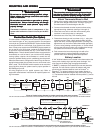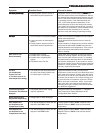
4
NOTE
CHECK CHECK
CHECK CHECK
CHECK
THERMOSTTHERMOST
THERMOSTTHERMOST
THERMOST
AA
AA
A
T OPERAT OPERA
T OPERAT OPERA
T OPERA
TIONTION
TIONTION
TION
To prevent static discharge problems, touch side ofTo prevent static discharge problems, touch side of
To prevent static discharge problems, touch side ofTo prevent static discharge problems, touch side of
To prevent static discharge problems, touch side of
thermostat to release static build-up before touchingthermostat to release static build-up before touching
thermostat to release static build-up before touchingthermostat to release static build-up before touching
thermostat to release static build-up before touching
any keys.any keys.
any keys.any keys.
any keys.
Do not allow the compressor to run unless the com-Do not allow the compressor to run unless the com-
Do not allow the compressor to run unless the com-Do not allow the compressor to run unless the com-
Do not allow the compressor to run unless the com-
pressor oil heaters have been operational for 6 hourspressor oil heaters have been operational for 6 hours
pressor oil heaters have been operational for 6 hourspressor oil heaters have been operational for 6 hours
pressor oil heaters have been operational for 6 hours
and the system has not been operational for at least 5and the system has not been operational for at least 5
and the system has not been operational for at least 5and the system has not been operational for at least 5
and the system has not been operational for at least 5
minutes.minutes.
minutes.minutes.
minutes.
CAUTION
!
If at any time during testing your system does not operate
properly, contact a qualified service person.
Fan Operation
If your system does not have a G terminal connection, skip to
Heating System.
1. Turn on power to system.
2. Move FAN switch to ON position. The blower should be-
gin to operate.
3. Move FAN switch to AUTO position. The blower should
stop immediately.
Heating System
1. Press SYSTEM button to select the Flame icon ( ). If
the auxiliary heating system has a standing pilot, be sure
to light it.
2. Press
to adjust thermostat setting to 1° above room
temperature. The heating system should begin to
operate. The display should show “STG1”. However, if
the setpoint temperature display is flashing, the compres-
sor lockout feature is operating (see Configuration menu,
item 5).
3. Adjust temperature setting to 3° above room temperature.
If your system configuration is set at MS2, HP2 or HP1,
the auxiliary heat system should begin to operate and the
display should show “STG1+2”.
4. Press
to adjust the thermostat below room tempera-
ture. The heating system should stop operating.
Emergency System
EMER bypasses the Heat Pump to use the heat source wired
to terminal E on the thermostat. EMER is typically used when
compressor operation is not desired, or you prefer back-up
heat only.
1. Press SYSTEM button to select EMER. “EMER” will flash
on the display.
2. Press
to adjust thermostat setting above room
temperature. The Aux. heating system will begin to
operate. The display will show “STG1” flashing “EMER”
and Flame icon (
) to indicate that the Aux. system is
operating.
3. Adjust temperature setting to 3° above room temperature.
The auxiliary heat system should begin to operate and
the display should show “STG1+2”.
4. Press
to adjust the thermostat below room tempera-
ture. The Aux. heating system should stop operating.
To prevent compressor and/or property damage, if theTo prevent compressor and/or property damage, if the
To prevent compressor and/or property damage, if theTo prevent compressor and/or property damage, if the
To prevent compressor and/or property damage, if the
outdoor temperature is below 50°F, DO NOT operateoutdoor temperature is below 50°F, DO NOT operate
outdoor temperature is below 50°F, DO NOT operateoutdoor temperature is below 50°F, DO NOT operate
outdoor temperature is below 50°F, DO NOT operate
the cooling system.the cooling system.
the cooling system.the cooling system.
the cooling system.
CAUTION
!
Cooling System
1. Press SYSTEM button to select the Snowflake icon ( ).
2. Press
to adjust thermostat setting below room
temperature. The blower should come on immediately on
high speed, followed by cold air circulation. The display
should show “STG1”.
3. Adjust temperature setting to 3° below room temperature.
The second stage cooling should begin to operate and
the display should show “STG1+2”.
4. Press
to adjust the temperature setting above room
temperature. The cooling system should stop operating.
Refer to equipment manufacturers' instructions for specific
system wiring information.
You can configure the thermostat for use with either multi-stage
electric heat systems or multi-stage gas systems. When config-
ured for electric heat, the G terminal (blower/fan) will be
energized on a call for heat.
This thermostat is designed to operate a single-transformer
system. If you have a two-transformer system, cut and tape off
Multi-Stage Terminal OutputsMulti-Stage Terminal Outputs
Multi-Stage Terminal OutputsMulti-Stage Terminal Outputs
Multi-Stage Terminal Outputs
one transformer. If transformer safety circuits are in only one of
the systems, remove the transformer of the system with NO
safety circuits. If required, replace remaining transformer with a
75VA Class II transformer. After disconnecting one transformer,
the two commons must be jumpered together.
Use the terminal output information below to help you wire the
thermostat properly for your multi-stage system. After wiring,
see CONFIGURATION section for proper thermostat configu-
ration.
SYSTEMSYSTEM
SYSTEMSYSTEM
SYSTEM
LL
LL
L
C*C*
C*C*
C*
RR
RR
R
W2W2
W2W2
W2
E/W1E/W1
E/W1E/W1
E/W1
Y2Y2
Y2Y2
Y2
Y1Y1
Y1Y1
Y1
GG
GG
G
OO
OO
O
BB
BB
B
Multi-stage Malfunction 24 Volt 24 Volt Heat Mode Heat mode Cool Mode Cool Mode Blower/Fan Energized Energized Energized
Light (Common) (Hot) 2nd stage 1st stage 2nd stage 1st stage on call for Cool (and in Cool in Heat, Off,
Heat if configured Mode Emergency
to Electric Heat) Modes
THERMOSTAT TERMINALS (MULTI-STAGE)THERMOSTAT TERMINALS (MULTI-STAGE)
THERMOSTAT TERMINALS (MULTI-STAGE)THERMOSTAT TERMINALS (MULTI-STAGE)
THERMOSTAT TERMINALS (MULTI-STAGE)
*The 24 volt neutral connection to terminal C on the thermostat is not required if you replace the batteries once a year with fresh “AA” alkaline batteries.














